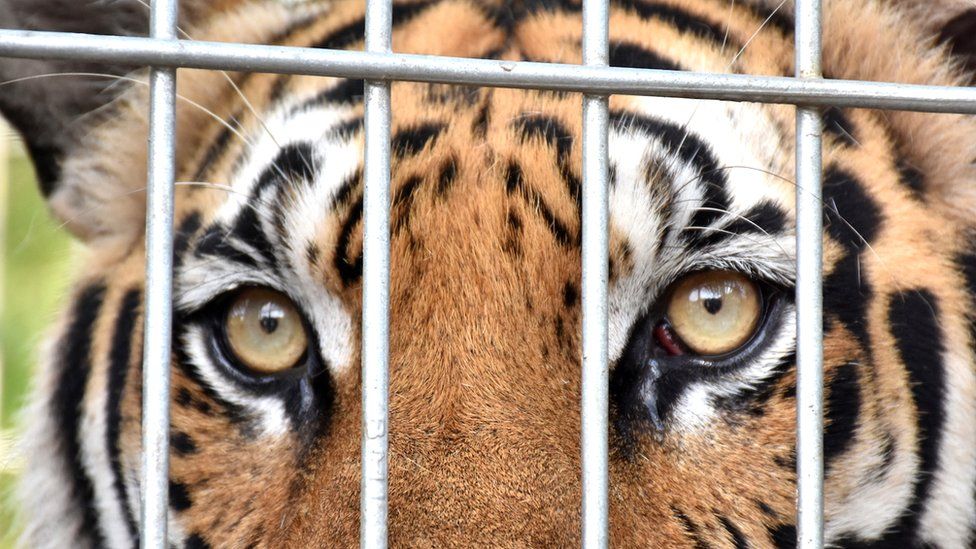Thai Tiger Temple's long history of controversy
- Published

Thailand's Tiger Temple is causing more controversy this week as authorities move to put an end to the popular tourist attraction. As the BBC explains, the temple has long been shrouded in allegations of animal abuse and trafficking.
What is the 'Tiger Temple'?
Tiger Temple, also known as Wat Pha Luang Ta Bu Yannasampanno, is located in Thailand's Kanchanaburi Province, west of Bangkok.
It received its first tiger cub in 1999 and an additional seven more in the same year. The temple was recorded to have at least 137 tigers in 2016.
The majority of the tigers are Bengal tigers, with others being hybrid breeds. There are also reports of jackals, hornbills and Asian bears being kept in the sanctuary without the necessary permits.
Visitors are charged 600 Thai Baht ($16, £11) for entry into the temple, with additional costs to pet or feed the tigers. And thousands of people flock to it every year to have their pictures taken with the animals.
There are other places in Thailand that also charge a fee to have close encounters with tigers, but this is the biggest and most popular with tourists by far, according to the Wildlife Friends Foundation of Thailand (WFFT), a non-governmental organisation (NGO) that has actively been campaigning for the release of the tigers since 2004.
What is the controversy?
Buddhist monks who run the temple have long faced accusations of mistreatment of tigers, illegal breeding and animal trafficking, all of which they have repeatedly denied.
Former workers have claimed the tigers are beaten, not well fed, in need of veterinary care and kept in small concrete cages. Earlier this year a National Geographic report alleged the monks are operating a for-profit breeding business.
There is evidence to suggest that wildlife trafficking has taken place, says the WFFT, without providing specific examples.
In December 2014, three adult male tigers vanished from the temple. They had been micro-chipped, a legal requirement for captive endangered animals in Thailand, which allows them to be tracked.
The temple's veterinarian Somchai Visasmongkolchai later came forward after resigning from his post to say that the microchips had been cut out of the three males.
What do the monks say?
The temple posted on its Facebook page on 4 March that posts accusing the temple of selling cubs to the black market were "not true", adding that some volunteers had "jumped to conclusions".
It added that allegations that the relocation of the tigers was due to animal welfare were "far from the truth".
The temple has an annual income of around 100m Thai Baht ($2.8m, £1.9m), according to the WFFT. The monks have also admitted to generating "some income" from tiger cub activities.
So why are the tigers being removed now?
There has been an ongoing battle between wildlife groups and the monks since 2001.
The Department of National Parks (DNP) has tried on multiple occasions to confiscate the tigers but was stopped from entering the temple by the monks.
More recently, the temple applied for a zoo licence that would have enabled them to legally continue holding the animals. This was provisionally granted, but then revoked soon after.
On Monday, authorities, the WFFT and other NGOs launched a large-scale raid on the tiger temple to confiscate the tigers.
"The monks were at this one small entrance gate, the only gate to the temple and they were refusing entry to anyone," Tom Taylor, assistant director of the WFFT, who was present at the time of the raid, told the BBC.
However, on Tuesday officials obtained a court order that allowed them to force their way in to the temple.
How is the operation being carried out?
A total of 40 tigers have been rescued within the first two day of the week-long operation, Mr Taylor said. At least 97 more tigers will be rescued in the 1,000 personnel operation.
However, the temple's lack of co-operation, which saw them release the tigers off the chains so it was harder for authorities to catch them, could see the operation extended, Mr Taylor said.
Four tigers also escaped overnight and started killing off other domestic animals in the premises. They were caught soon after.
NGOs and authorities are also now feeding the tigers still remaining in the temple, as the monks have now refused to feed the animals, Mr Taylor said.
On Wednesday, an additional 40 dead tiger cubs were found in the temple's freezer. Additional animal body parts were also found by authorities.
What will happen to the tigers?
The tigers will be transferred to two governmental breeding centres in Thailand's Ratchaburi Province.
They will not be released to the wild as they would have little chance of survival.
"The fact that they are hand-raised tigers means they have very little fear of humans or wildlife instincts. So at the moment, the plan is to provide them with wildlife care," said Mr Taylor. "They would not be able to survive in the wild."
- Published1 June 2016
- Published31 May 2016
- Published31 May 2016
- Published22 August 2023